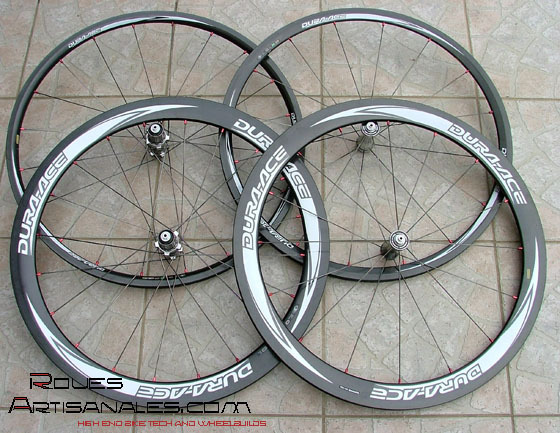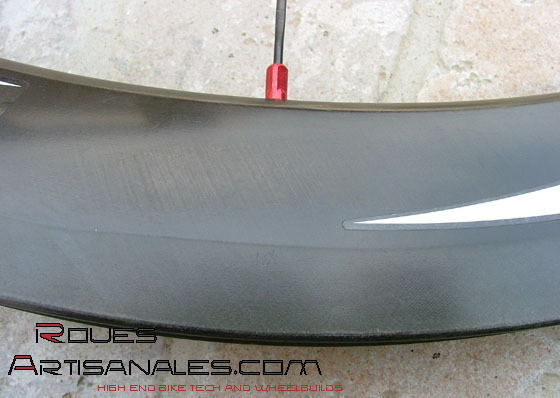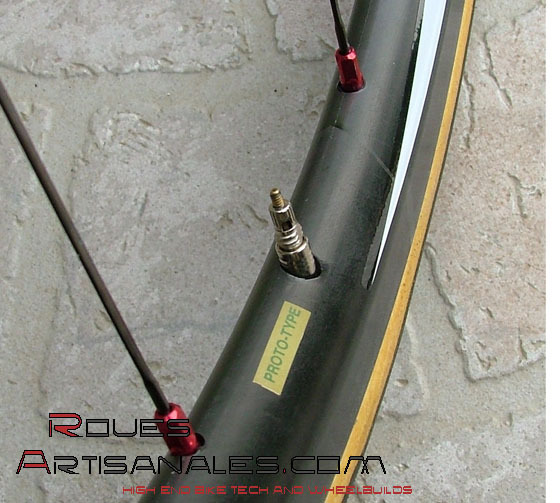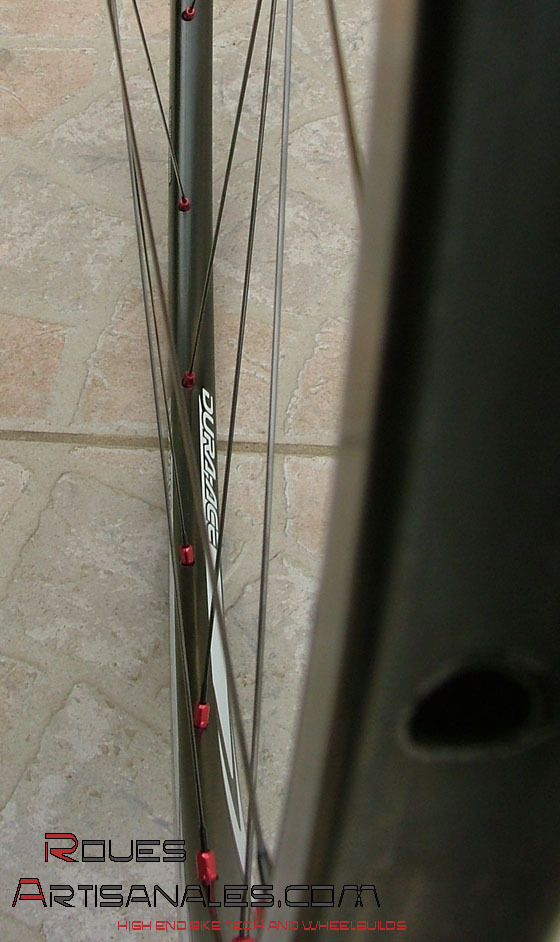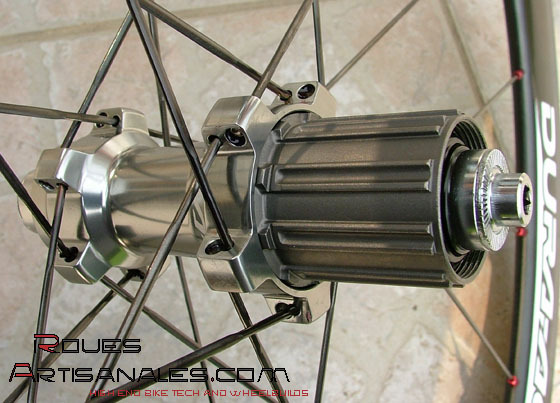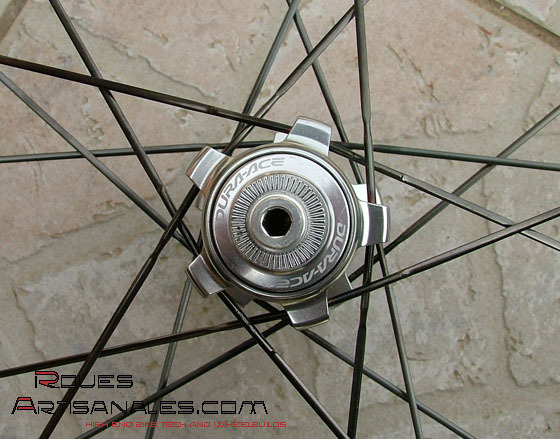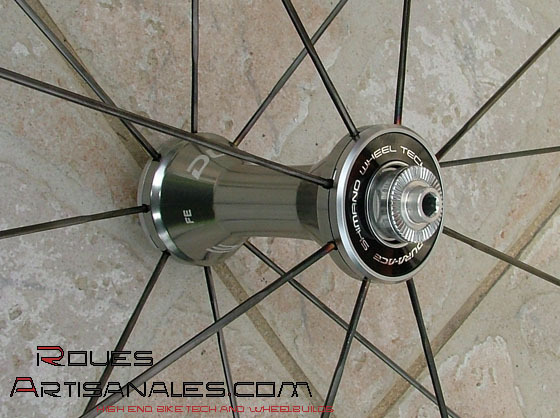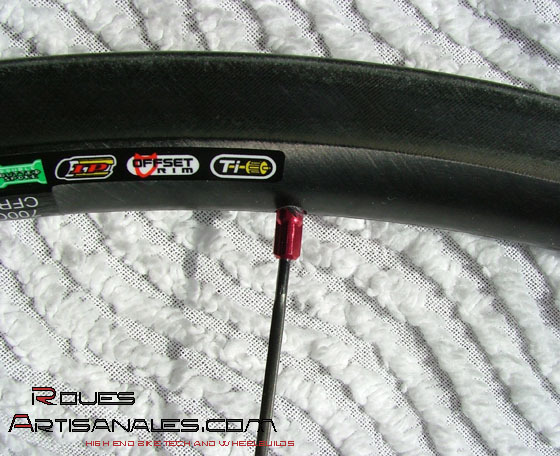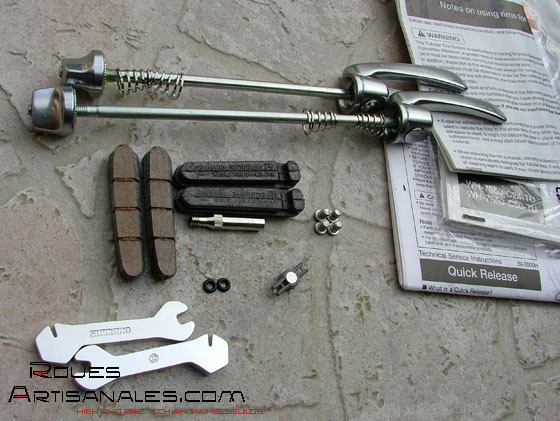Here are the latest wheels of Shimano, available from this month. 7850 C24 TU and 7850 C50 TU are the model names. 7850
for the range: the newest generation of Dura-Ace, C24 or C50 for Carbon followed by the rim height in millimeter, and TU for tubular. These wheels follow the 7801 Carbon 50mm which hit the market
mid 2006. We presented these wheels in two articles mid 2005 and by the end of 2005.
So the 7850 are among the batch of wheels we will test with the help of Mavic and the french magasine L’Acheteur Cycliste. Let’s see in details what these wheels
features and what are their pros and cons.
For two years, Shimano has made its own carbon wheels. The first generation, as mentioned above, had a deep rim (then flatter rimmed wheels appeared) and the special nipple system around the hub.
The rear wheel had a special spoke pattern a la Ksyrium: radial spokes on the freewheel side and crossed spokes on the non-drive-side spokes. This gives more balanced spoke tension on both sides of
the wheel.
For 2008, the latest Shimano wheels use a more traditional pattern – two times crossed on both sides – and external nipples on the rim. As a standard wheel, the weight of the C24 TU wheelset is
1246g. The C50 TU set weights 1489g.
It seems Shimano focused on the finish of this part of the wheel. The carbon of the C24 TU rims is almost invisible, ok the rim is black but usually the carbon has some defects… here there
is no imperfection. The rim is almost as well finished as an anodized alluminium rim. Under some light angles, you can see the uni-directional fibre beautifully placed but it’s hard to spot. This
is a big plus point for Shimano and makes for superb looking rims, nicer than most of the competitors.
On the C50, the fibre is more visible because of the bigger side area. Some will like it and others not. We are not particular fans of very visible carbon fibre but prefer the discreet look of
these wheels.
The carbon joint is visible however. This is the only negative we can provide to balance the description.
In terms of construction, the C24 and C50 rims are hollow. Both the front and rear C50 rims are identical while the C24 are different. The front rim is symetrical, 28mm deep while the rear one is
asymetrical and 24mm deep. The asymetry is still quite rare on carbon rims and was first introduced with the Campagnolo Hyperon. Only a few manufacturers do this. We can quote Mavic as the
first to introduce an asymetrical carbon deep rim with the Cosmic Carbone Ultimate.
The asymmetry increases the drive side bracing angle and reduces it on the opposite side to improve balance and allow a better spoke tension balance on the rear wheel. On a rear C24, the asymetry
is 3mm.
The C24 rim weight is close to 310g, Shimano claims. Thus, the C50 should be close to 430g after a simple calculation taking into account the similar spokes and hubs.
The rims sides are very stiff, unlike Zipp rims for example. This bodes well for the wheel stiffness. Labs tests will give us some proper data to verify this.
The tubular bed reveals a very poor finish, which is certainly due to the manufacturing process. This reminds us of the Lew Racing Pro VT1 rims, probably due to similarities between manufacturing
processes. Once the first layer of glue is applied, those defects will be invisible, so we will not comment on this further.
The hubs have also been updated for 2008. A different spoking pattern comes with a new hub, at least for the biggest manufacturers. The new hubs’ shape has been designed to deal with straight
pull spokes (the spoke is not bent).
flanges of a Tune Mag190 is 57mm, on the Lightweight: 58mm and on the mavic CCU: 55mm (+ asymetry). The rear hub also receives a new rotor, entirely made out of titanium and compatible with 8s,
9s and 10s cassettes. The splines to position the cassette are lightened, actually each spline is divided in 2 smaller splines. This kind of machinning was originally featured on the DT190
Ceramic hub.
A new faster freewheel engagement has been developed too. Some ocassional irregular and unwanted noise and friction seemed to slow down spinning of the wheels but they may just need breaking
in.
Shimano claims these new rear hubs have 400% better seals than the previous model. It’s hard to tell because the rear hub bearing actually spins better than the front one. Usually it’s the other
way round because the rear wheel has the rotor that causes extra friction. Again we will see after the breaking in period.
These hubs feature the legendary system with cups and balls, they are very easy to set and very fluid after a few hundred kilometers.
About the spokes, as mentioned above, they are radial for the front wheel and crossed on both sides of the rear wheel. They are crossed but there is no contact between spokes. This allows the
spoke to take the perfect line and improves the bracing angle.
The dimensions are exactly the same as Sapim Cx-ray or DT Aerolite.

The nipples are aluminium and… are red! This is a nice touch of exotism from Shimano. Even though the red is only used here, it’s a nice touch.
The kit provided with each wheelset included everything we needed to use them:
– quick releases
– carbon Shimano brake pads plus pad holder bolts
– magnet
– a valve extender
– seals to prevent the periodic ‘tic-tic » noise when the wheels spin
– spoke keys
These wheels, 2008 model, seem to be pretty good on all aspects: finish, integration of each component of the wheel, look and weight, at least for the C24. The C50 is a little heavy versus
competitors. Of course, it hasn’t been designed for the mountains to but the 430g rim is a bit heavy compared with the Zipp 404 rims for example (390g). A heavy rim will maintain speed better
on the flat however.
Here are two tables summarizing the competitors of these wheels:
| Model |
Rim height |
Weight |
| Shimano 7850 C24 TU | 28/24mm | 1246g (real) |
| Shimano 7801 Carbone (until 2007) | 28/24mm | 1325g (real) |
| Campagnolo Hyperon | 19/21mm | 1220g (claimed) |
| Corima Winium | 21mm | 1295g (claimed) |
| Speedcomposites | 25mm | de 970g à 1090g |
| Zipp 202 (model 2007) | 25mm | 1090g (claimed) |
| Lightweight Ventoux DT | 27mm | 1020g (claimed) |
| Reynolds KOM | 23mm | 1063g (claimed) |
| Modèle | Hauteur de jante | Poids |
| Shimano 7850 C50 TU | 50mm | 1489g (real) |
| Shimano 7801 Carbone 50 (until 2007) | 50mm | 1525g (real) |
| Campagnolo Bora Ultra | 50mm | 1305g (claimed) |
| Corima Medium | 45mm | 1330g (claimed) |
| Zipp 404 | 58mm | 1252g (claimed) |
| Lightweight Standard | 53mm | 1060g à 1090g (claimed) |
| Reynolds DV46T | 46mm | 1315g (claimed) |
| Easton Tempest 2 Carbon | 56mm | 1265g (claimed) |

